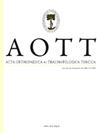颈关节韧带断裂对颈椎后路手术后临床疗效的影响:一项回顾性比较研究
IF 1.1
4区 医学
Q3 ORTHOPEDICS
引用次数: 1
摘要
目的:本研究旨在探讨修复后颈韧带(NL)的断裂是否会影响颈椎后路手术后的临床结果。方法:本回顾性研究纳入101例(男性65例,女性36例)后路颈椎手术患者,其中69例行椎板成形术(LP), 32例行后路减压融合术(PDF)。NL在手术入路时裂开,并在伤口关闭时修复。在术后1个月、6个月和1年通过中矢状面和轴向面磁共振图像评估NL断裂的频率和脊柱水平。术后6个月和/或1年检查术后轴向症状、颈部残疾指数、T1坡度、屈伸角、C2-C7前凸角和C2-C7活动范围(ROM)下降率。根据NL破坏程度将患者分为上组(C2-C5)、下组(C6-T1)和非破坏组。结果:虽然在最后随访时,下层组有LP后NL中断的患者(10%),但所有PDF患者都属于非中断组。对于LP患者,术后轴向症状、颈部残疾指数、T1坡度、屈伸角和C2-C7前凸角在下肢和非骨折组之间无显著差异;然而,LP后,低干扰组的C2-C7 ROM下降率(48%)明显大于非干扰组(33%)。结论:本研究证据表明,术后修复的NL断裂对术后轴向症状和C2-C7对位无明显影响,但会影响LP术后C2-C7 ROM的下降速度。证据等级:III级,治疗性研究本文章由计算机程序翻译,如有差异,请以英文原文为准。
The effect of disruption of the repaired nuchal ligament on clinical outcomes after posterior cervical spine surgery: A retrospective comparative study
Objective: This study aimed to investigate whether disruption of the repaired nuchal ligament (NL) affects clinical outcomes following posterior cervical spine surgery. Methods: This retrospective study included 101 patients (65 males, 36 females) who underwent posterior cervical spine surgery, 69 of whom received laminoplasty (LP), and 32 posterior decompression and fusion (PDF). The NL was split during the surgical approach and repaired at the time of wound closure. The frequency and spinal levels of NL disruption at one month, six months, and one year postoperatively were evaluated on mid-sagittal and axial magnetic resonance images. Postoperative axial symptoms, Neck Disability Index, T1 slope, flexion and extension angle, C2-C7 lordotic angle, and decrease rate of C2-C7 range of motion (ROM) were examined at six months and/or one year postoperatively. Based on the NL disruption levels, the patients were divided into the upper group (C2-C5), lower group (C6-T1), and non-disruption group. Results: Although the lower group contained patients with NL disruption (10%) after LP at final follow-up, all PDF patients belonged to the non-disruption group. For the LP patients, the postoperative axial symptoms, Neck Disability Index, T1 slope, flexion and extension angle, and C2-C7 lordotic angle did not significantly differ between the lower and non-disruption groups; however, the rate of C2-C7 ROM decrease in the lower group (48%) was considerably larger than that in the non-disruption group (33%) after LP. Conclusion: Evidence from this study has shown that postoperative disruption of the repaired NL has no significant effect on postoperative axial symptoms and C2-C7 alignment, but it can affect the rate of decrease in C2-C7 ROM after LP. Level of Evidence: Level III, Therapeutic Study
求助全文
通过发布文献求助,成功后即可免费获取论文全文。
去求助
来源期刊

Acta orthopaedica et traumatologica turcica
ORTHOPEDICS-
CiteScore
2.00
自引率
0.00%
发文量
66
审稿时长
>12 weeks
期刊介绍:
Acta Orthopaedica et Traumatologica Turcica (AOTT) is an international, scientific, open access periodical published in accordance with independent, unbiased, and double-blinded peer-review principles. The journal is the official publication of the Turkish Association of Orthopaedics and Traumatology, and Turkish Society of Orthopaedics and Traumatology. It is published bimonthly in January, March, May, July, September, and November. The publication language of the journal is English.
The aim of the journal is to publish original studies of the highest scientific and clinical value in orthopedics, traumatology, and related disciplines. The scope of the journal includes but not limited to diagnostic, treatment, and prevention methods related to orthopedics and traumatology. Acta Orthopaedica et Traumatologica Turcica publishes clinical and basic research articles, case reports, personal clinical and technical notes, systematic reviews and meta-analyses and letters to the Editor. Proceedings of scientific meetings are also considered for publication.
The target audience of the journal includes healthcare professionals, physicians, and researchers who are interested or working in orthopedics and traumatology field, and related disciplines.
 求助内容:
求助内容: 应助结果提醒方式:
应助结果提醒方式:


